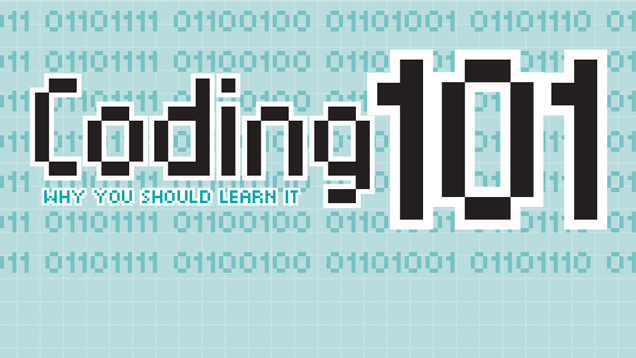Coding 101
 CREDIT: CANDIS BROSS
CREDIT: CANDIS BROSSCode is everywhere. Zeros and ones fly constantly around us, invisible yet ever present in the new world ruled by technology. Whether you’re in the IT field or not, knowing a bit about how programs work and how they’re made is quickly becoming a necessary skill. Luckily, there are many ways to get started with the language of your choice.
Block coding
Block coding isn’t a proper language, but instead is a great way to learn the basics of how code works, simplified in a way to make sense even if you’ve never touched a keyboard to do more than head to Facebook. This is an excellent method to learn about sequential problem solving, for loops – which basically make to computer do something over and over until told to stop – and visualizing what programs are doing when you click Run. Block coding is used by some universities to introduce students to the basics, and is great if you don’t want to get bogged down in the details that come with learning a more complicated language.
Best place to learn it:
Hour of Code
(code.org)
HTML/CSS
While not a proper programming language – this is code that runs inside another program like Chrome or Internet Explorer instead of creating a program itself. HTML is the backbone of every website and CSS is how we make those websites pretty, with another language, usually JavaScript, being used to make the websites interactive. HTML and CSS are great for beginners, because it’s very easy to make changes and see them happen in your favourite Internet browser as you go. All you have to do is refresh the page to see your work come to life.
Best place to learn it:
Khan Academy
(tinyurl.com/nobba65)
Codecademy
(codecademy.com)
SQL
Databases are everywhere. From Twitter to World of Warcraft, almost every website, program, game and app has a database quietly working in the background, full of information and constantly adding more. SQL is the key to accessing this information, and is used by a large variety of professions on a daily business. Like HTML, SQL isn’t considered a proper programming language and needs to be run in another program, but without SQL all of that data would just sit in the ether, forever unchangeable and inaccessible. Luckily, SQL is a relatively simple language. There are only a few basic key commands that are easy to remember as they generally do exactly what you would expect – such as the Select command, which just picks whatever columns you ask for from a specific table in your database. SQL was also standardized in 1986, which means you can generally run it in any database with only a few tweaks.
Best place to learn it:
Khan Academy
(tinyurl.com/nobba65)
Python
Named after Monty Python, this is a language that often reads like English, mixing simplified commands with proper code format to give a nice learning environment for beginners. Those programming in Python, and the people designing the learning courses, tend to revel in the Monty Python connection, so expect a lot of references to Monty Python and the Holy Grail while making your way through the lessons. Designed to be concise and readable, opening the code for a program that was written in Python often feels like opening a well-written instruction manual. It’s also a general-purpose language, which means it can be used to make a wide variety of applications or programs. Like block coding, this is a language that is often used to teach university students the basics of coding, but it’s still advanced enough to make it extremely useful for businesses. Python is also a great middle ground to learn how to read code languages, which tend to follow their own special grammar rules.
Best place to learn it:
Codecademy
(codecademy.com)
C/C++
Older, more powerful and a bit more complicated, C and C++ are the powerhouses of the programming world. Used to make everything from operating systems to video games, learning C or C++ is as valuable as it is challenging. These are the languages that inspired so many others, including C#, Java and Python. The key to learning C/C++ is to not feel intimidated by the language, which can feel pretty dense and foreign at times. For the most part, the worst that will happen is you get a scary looking error message and maybe have to restart your computer. There’s nothing to fear, though, and there are a ton of websites where programmers stand at the ready to help you if you get stuck. Just do a Google search for your error, because it’s guaranteed to have happened to someone else before.
Best place to learn it:
Learn C++
(learncpp.com)














